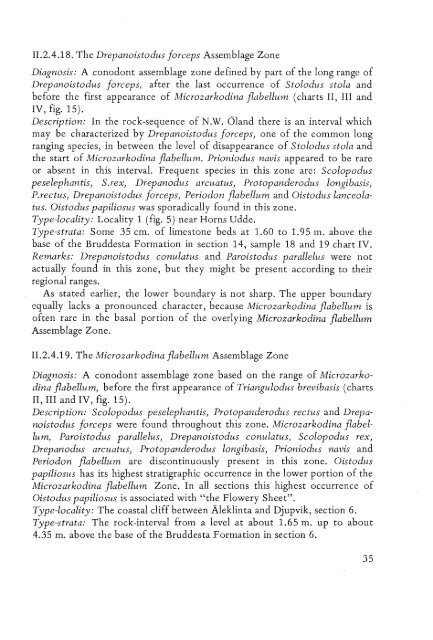UTRECHT MICROPALEONTOLOGICAL BUllETINS
UTRECHT MICROPALEONTOLOGICAL BUllETINS
UTRECHT MICROPALEONTOLOGICAL BUllETINS
You also want an ePaper? Increase the reach of your titles
YUMPU automatically turns print PDFs into web optimized ePapers that Google loves.
11.2.4.18. The Drepanoistodus forceps Assemblage Zone<br />
Diagnosis: A conodont assemblage zone defined by part of the long range of<br />
Drepanoistodus forceps, after the last occurrence of Stolodus stola and<br />
before the first appearance of Microzarkodina flabellum (charts II, III and<br />
IV, fig. 15).<br />
Description: In the rock-sequence of N.W. Oland there is an interval which<br />
may be characterized by Drepanoistodus forceps, one of the common long<br />
ranging species, in between the level of disappearance of Stolodus stola and<br />
the start of Microzarkodina flabellum. Prioniodus navis appeared to be rare<br />
or absent in this interval. Frequent species in this zone are: Scolopodus<br />
pese lephan tis, S.rex, Drepanodus arcuatus, Protopanderodus longibasis,<br />
P.rectus, Drepanoistodus forceps, Periodon flabellum and Oistodus lanceolatus.<br />
Oistodus papiliosus was sporadically found in this zone.<br />
Type-locality: Locality 1 (fig. 5) near Horns Udde.<br />
Type-strata: Some 35 em. of limestone beds at 1.60 to 1.95 m. above the<br />
base of the Bruddesta Formation in section 14, sample 18 and 19 chart IV.<br />
Remarks: Drepanoistodus conulatus and Paroistodus parallelus were not<br />
actually found in this zone, but they might be present according to their<br />
regional ranges.<br />
As stated earlier, the lower boundary is not sharp. The upper boundary<br />
equally lacks a pronounced character, because Microzarkodina flabellum is<br />
often rare in the basal portion of the overlying Microzarkodina flabellum<br />
Assemblage Zone.<br />
11.2.4.19. The Microzarkodina flabellum Assemblage Zone<br />
Diagnosis: A conodont assemblage zone based on the range of Microzarkodina<br />
flabellum, before the first appearance of Triangulodus brevibasis (charts<br />
II, III and IV, fig. 15).<br />
Description: Scolopodus peselephantis, Protopanderodus rectus and Drepanoistodus<br />
forceps were found throughout this zone. Microzarkodina flabellum,<br />
Paroistodus parallelus, Drepanoistodus conulatus, Scolopodus rex,<br />
Drepanodus arcuatus, Protopanderodus longibasis, Prioniodus navis and<br />
Periodon flabellum are discontinuously present in this zone. Oistodus<br />
papiliosus has its highest stratigraphic occurrence in the lower portion of the<br />
Microzarkodina flabellum Zone. In all sections this highest occurrence of<br />
Oistodus papiliosus is associated with "the Flowery Sheet".<br />
Type-locality: The coastal cliff between Aleklinta and Djupvik, section 6.<br />
Type-strata: The rock-interval from a level at about 1.65 m. up to about<br />
4.35 m. above the base of the Bruddesta Formation in section 6.
















